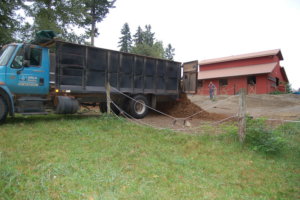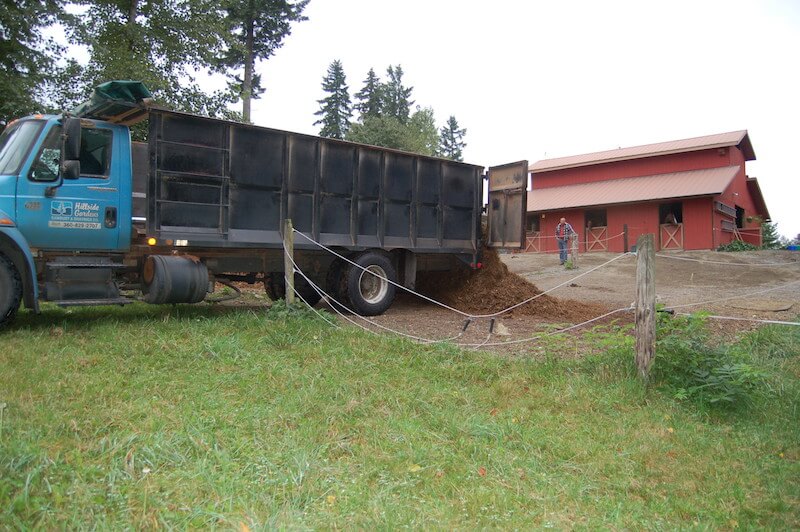Make Your Paddocks and Barn Chore-efficient
by Alayne Blickle, Program Director, Horses for Clean Water
This month we’ll cover tips to help ease you through those times ahead when you least want to deal with winter’s little—and big—surprises.
Buy your winter supply of hay. Be sure to look for green, leafy, fresh-smelling hay without mold, weeds, dust or discoloration. Most recent nutritional recommendations are that a horse should receive 2% of its body weight in hay (or forage) per day. For the “average” 1000 pound horse with moderate exercise that will be about 20 pounds of hay per day or about 600 pounds of hay per month. Since hay is usually sold in bulk by the ton (2,000 pounds), one ton of hay will last about three and 1/3 months per average-sized horse. So, do the math to determine how many tons of hay you’ll need for the winter. If you don’t have the room for storing that volume of hay, perhaps a horsey neighbor might. Two (or more) of you could go in on the purchase of the hay and reduce the cost for all. Another point to consider is that a couple extra pounds of hay fed on extremely cold nights is the best heat source you can provide your horse. Body heat generated by eating and digesting the hay will help keep your horse warm. One final point: to avoid over or under feeding your horse always weigh your hay (and grain!) Feeding by eye or scoop is not accurate and wastes feed and money.
Purchase bedding for the wet months. Pelleted beddings are readily available and are a cost-effective alternative that are highly absorbent and compost well. Pelleted beddings come bagged and with the addition of a cover you may be able to store them outside in a very small area. Horse health benefits may include that they are very low in dust, a concern if either you or your horse have respiratory issues.
 Bring in footing material for paddocks, confinement areas and other high traffic areas. Now is the time to think about the hog fuel or gravel you will need for footing in sacrifice areas, paddocks, walkways, and in front of gates. These materials are more available in the fall before demand is high. Plus, it is much easier for delivery trucks to back into paddocks and drive through pastures now rather than once these areas have become a slick and muddy mess.
Bring in footing material for paddocks, confinement areas and other high traffic areas. Now is the time to think about the hog fuel or gravel you will need for footing in sacrifice areas, paddocks, walkways, and in front of gates. These materials are more available in the fall before demand is high. Plus, it is much easier for delivery trucks to back into paddocks and drive through pastures now rather than once these areas have become a slick and muddy mess.
Tarp your manure piles. This will help keep the nutrients you are trying to save IN the compost and not allow them to get washed OUT into the surface waters where they can cause a potential problem. Be sure to store manure as far away as possible from streams, ditches or wetlands to avoid potential environmental problems.
Review your lighting needs. Do you have adequate outdoor lighting? Are your stalls bright enough to care for your horses during dark evenings? When you’re feeding at night will you have enough light to see if the hay you’re feeding is green—or could it be moldy? Would you be better able to do your manure pick-up chores in the paddocks if you had flood lighting? Have you been meaning to put in lighting along walkways or drives? Get an electrician in now and get that work done instead of waiting until temperatures are freezing and you’re trying to feed by flashlight.
Following these tips will keep you ahead of the majority of problems and have you better prepared for the long winter months. Get moving on these chores so both you and your horse will be more comfortable and better able to cope with our upcoming Northwest winter.
It may be brown (or white!) outside but you can make your horse property green by joining Horses for Clean Water and putting green horse keeping on the ground:
SPOKANE, WA
Get Rid of Mud, Manure & Weeds! Keeping Horses & Livestock on Small Acreage.
Saturday, November 5, 9am to 2pm
Join Alayne Blickle, creator of the award-winning program Horses for Clean Water, to find out new and exciting ways to make your horse property chore efficient, easier to care for this coming winter, healthier for horses with fewer bugs and more productive during next summer’s growing season. Contact the Spokane Conservation District at 509-535-7274, ext 31, or pat-munts@sccd.org.
BLACK DIAMOND, WA
Pasture Workshop for Horse & Small Farm Owners
November 10, 6:30 pm to 9p Black Diamond Library
Growing Grass/Producing Forage. Yes, you can grow grass without weeds and meet your livestock forage needs—even on small acreage! FREE! With a King County noxious weed specialist to talk about weed ID & control.
Discover what’s possible based on your finances, time and ability. Attend this workshop to:
- Develop a pasture management plan
- Determine the grazing capacity of your pastures
- Learn how to manage grazing for optimal pasture production
- Learn about regulations in effect
- Find out about cost-sharing programs available
- Meet free resource technicians available to assist you.
Register and receive directions for all King Conservation District educational events at 425-282-1949 or signup@kingcd.org.
GARDEN CITY, ID
Composting and Manure Management Options for Horse & Livestock Owners.
Saturday, January 21, 2-3:30pm, Boise Watershed
Join Alayne Blickle at the Boise WaterShed for Composting and Manure Management Options for Horse & Livestock Owners.There are many useful alternatives to stockpiling stall waste. In this presentation learn about options that will make your place healthier for horses and livestock, reduce insect populations, help your property to be more productive during the growing season, AND make it chore-efficient this winter! For more info Alayne@horsesforcleanwater.com
Published November 2011 Issue

Alayne Blickle, a life-long equestrian and educator, is the creator/director of Horses for Clean Water, an award-winning, nationally acclaimed environmental education program that “wrote the book” on caring for horses and land. Known for her enthusiastic, fun and down-to-earth approach, she is an educator and photojournalist who has worked with horses and livestock owners for over 20 years. Alayne teaches and travels throughout North America and abroad, and also runs Sweet Pepper Ranch, an eco-sensitive guest ranch and horse motel in Southwestern Idaho where she and her husband raise top-notch reining horses and beautiful grass hay. For more information contact Alayne at alayne@horsesforcleanwater.com or 206-909-0225.

